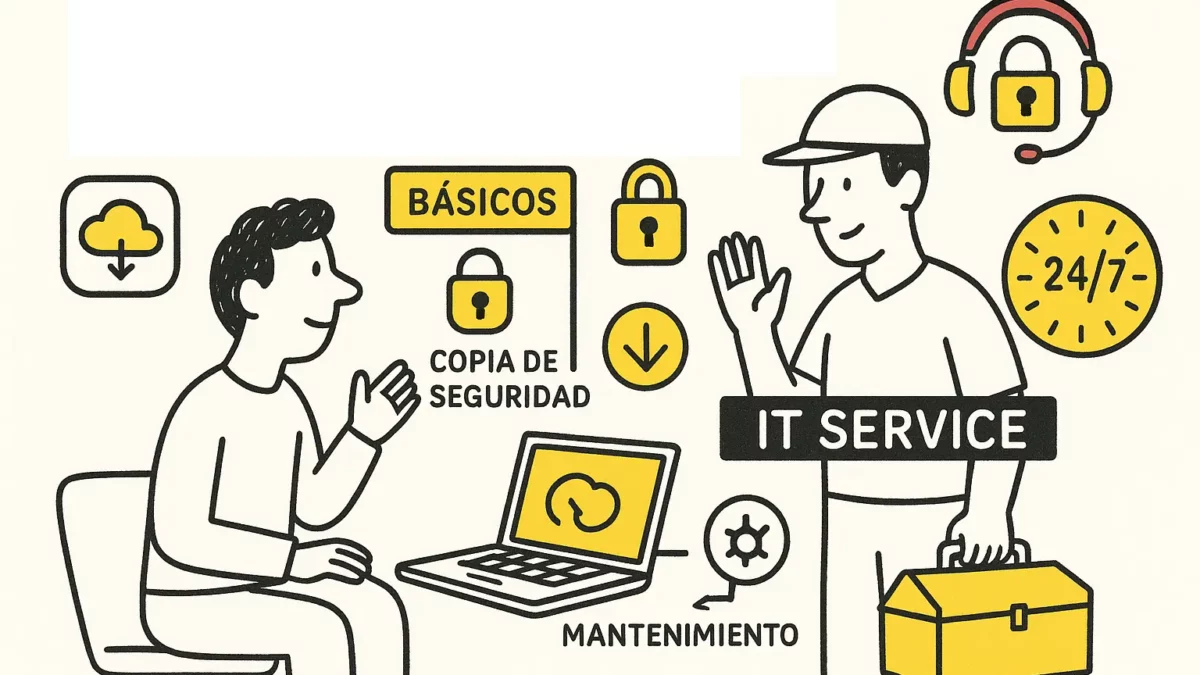IT maintenance is not just about fixing problems — it’s about preventing them before they impact your business. A well-maintained IT environment ensures productivity, protects data, and extends the lifespan of your equipment. In this practical guide, we’ll explain, step by step, how to implement an effective IT maintenance plan for your company.
1. Analyse your technological infrastructure
The first step is to understand the real state of your systems. Take an inventory of all devices, servers, networks, and software, classifying each item by its level of criticality. This will allow you to prioritise maintenance actions and plan future investments wisely.
- Identify active devices and their age.
- Record licences, versions, and renewal dates.
- Detect bottlenecks or outdated equipment.
This initial assessment will provide a solid foundation for the rest of your plan.
2. Establish an update schedule
Regular updates are essential to maintain system security and stability. Set up a schedule that includes security patches, firmware, drivers, and critical software.
- Plan monthly reviews of servers and workstations.
- Automate updates wherever possible.
- Document every change to avoid conflicts or repeated errors.
A well-managed update policy reduces risk and ensures a reliable operating environment.
3. Implement protection and monitoring measures
Without visibility or security, maintenance loses its effectiveness. It’s essential to have advanced protection systems and continuous monitoring to anticipate issues before they escalate.
- Install XDR or next-generation antivirus solutions for endpoints and servers.
- Apply antispam filtering, web access control, and multi-factor authentication (MFA).
- Enable 24/7 monitoring of your network, performance, and cybersecurity.
These best practices, aligned with industry standards, help detect anomalies and enable a proactive response.
4. Ensure secure and verified backups
An IT maintenance plan without reliable backups is an unacceptable risk. Implement a 3-2-1 backup strategy: three copies, on two different media, with one stored offsite or in the cloud.
- Perform daily backups of critical data.
- Regularly verify the integrity of your backups.
- Test restoration to ensure appropriate recovery times.
IT maintenance isn’t only about prevention — it’s also about being able to recover quickly when something unexpected occurs.
5. Standardise processes and documentation
Documentation is key to keeping maintenance sustainable and repeatable. Create clear procedures (SOPs) that define how to act in each type of incident or routine task.
- User onboarding and offboarding protocols.
- Incident and priority management (SLA).
- Templates for changes and preventive reviews.
With well-defined processes, any technician can intervene efficiently and with full traceability.
6. Train your team and promote best practices
People are the most important link in operational continuity. Train users in responsible device usage and basic digital security measures.
- Organise quarterly micro-trainings on phishing and secure passwords.
- Communicate official support procedures and channels.
- Encourage communication between users and the IT department.
Prevention starts with company culture, not just technology.
7. Evaluate results and drive continuous improvement
IT maintenance should be measured using clear metrics. Periodically review results and adjust your plan as your technological environment and business needs evolve.
- Measure the mean time to resolution (MTTR) of incidents.
- Monitor the percentage of updates applied on time.
- Review monitoring and backup reports every month.
Continuous improvement turns maintenance into a strategic tool for efficiency and security.
How Inmove IT Solutions helps you
At Inmove IT Solutions, we support you throughout the entire process — from the initial audit to day-to-day operations. Our team combines technical expertise, proactive monitoring, and local support in Barcelona to ensure maximum continuity.
Related articles
If you want to continue improving your IT management, we recommend:
- IT Maintenance: How to Ensure Operational Efficiency
- How Cloud Computing Transforms Your Business
- How to Protect Your Business from Cyberattacks
Conclusion
Implementing an IT maintenance plan doesn’t require large investments — just consistency, method, and a strategic vision of your IT environment. With preventive management and professional support, your company can avoid downtime, strengthen security, and optimise resources.
Want to take your infrastructure to the next level? Contact our team and discover how a 24/7 IT maintenance plan can make all the difference.
Frequently Asked Questions (FAQ)
Here we answer the most common questions about IT maintenance to help you make informed decisions and confidently follow this step-by-step guide.
How often should I apply updates and patches?
As a general rule, apply critical patches within seven days and all others in the next maintenance window. Group devices by “pilot” and “production” to minimise risk, and document every change.
What’s the difference between preventive and corrective maintenance?
Preventive maintenance avoids issues through reviews, patches, monitoring, and backups. Corrective maintenance acts after a problem occurs. An effective plan prioritises prevention to reduce downtime and costs.
What should an IT maintenance contract include?
At minimum: service scope, SLAs by priority, support hours, response times, escalation procedures, monthly reports, and a continuity plan. For full coverage, consider 24/7 IT maintenance.
How can I ensure my backups actually work?
Apply the 3-2-1 strategy, check backup status daily, and schedule quarterly restoration tests with defined RPO/RTO objectives. Include these results in your monthly reports.
Do SMEs really need 24/7 monitoring?
Yes, if your business depends on critical systems or relies on remote work and cloud services. 24/7 monitoring detects anomalies before they affect users and allows proactive response.
Should I outsource maintenance or manage it internally?
A hybrid model is usually best: an internal coordinator for priorities and user relations, and an external partner for continuous operation, automation, and escalation. Explore our IT outsourcing service.
What metrics should I track to know if the plan works?
Monitor MTTR, service availability, patch compliance, backup success rate, ticket categories, and user satisfaction (CSAT). Use a monthly dashboard and quarterly improvement reviews.
How should I manage legacy or unsupported software?
Assess risks and dependencies, segment the network, restrict privileges, and plan its replacement with clear milestones and budget. If the system is critical, create a controlled transition plan and reinforced backups.
What about Macs, Linux, and mobile devices?
Include them in your inventory, patch policies, security (MFA, encryption), and monitoring. Define MDM profiles for laptops and mobiles, and standardise system images by role.
Does moving to the cloud change maintenance requirements?
Yes: you reduce on-premise hardware, but governance, security, cost control, and SaaS/IaaS backup tasks increase. Follow this guide and check our content on cloud migration to avoid hidden cloud migration costs.
How should I manage daily user requests?
Centralise everything in a ticketing portal with categorisation, templates, and a knowledge base. Our remote helpdesk applies SLAs and reports root causes to reduce recurring incidents.

